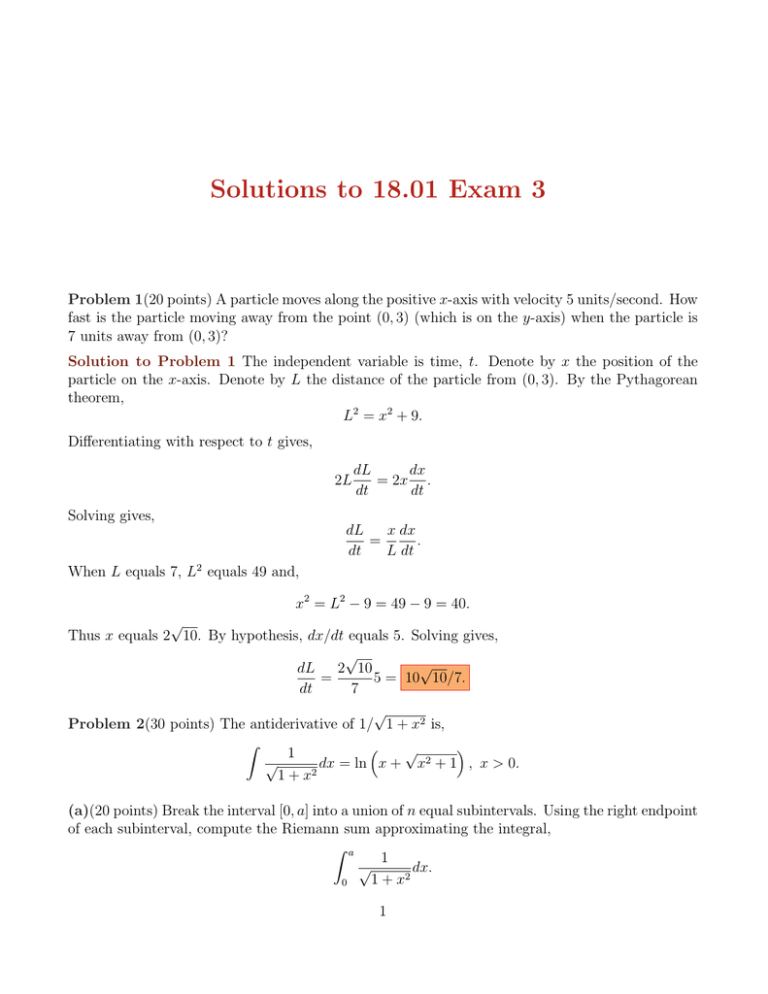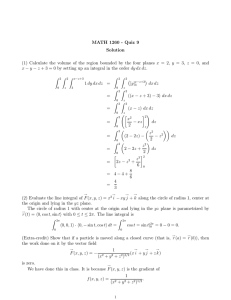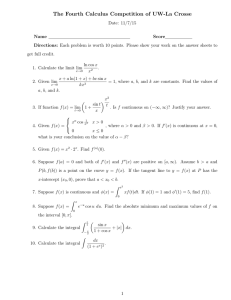Document 13555061
advertisement

Solutions to 18.01 Exam 3 Problem 1(20 points) A particle moves along the positive x­axis with velocity 5 units/second. How fast is the particle moving away from the point (0, 3) (which is on the y­axis) when the particle is 7 units away from (0, 3)? Solution to Problem 1 The independent variable is time, t. Denote by x the position of the particle on the x­axis. Denote by L the distance of the particle from (0, 3). By the Pythagorean theorem, L2 = x2 + 9. Differentiating with respect to t gives, 2L dL dx = 2x . dt dt Solving gives, dL x dx = . dt L dt When L equals 7, L2 equals 49 and, x2 = L2 − 9 = 49 − 9 = 40. √ Thus x equals 2 10. By hypothesis, dx/dt equals 5. Solving gives, √ √ dL 2 10 = 5 = 10 10/7. dt 7 √ Problem 2(30 points) The antiderivative of 1/ 1 + x2 is, � � � √ 1 2 √ dx = ln x + x + 1 , x > 0. 1 + x2 (a)(20 points) Break the interval [0, a] into a union of n equal subintervals. Using the right endpoint of each subinterval, compute the Riemann sum approximating the integral, � a 1 √ dx. 1 + x2 0 1 Leave your answer in the form of a sum. But simplify as much as possible. Show all work. Solution to (a) The partition of [0, a] into n equal subintervals has right endpoints, xk = ka a , Δxk = . n n The instructions are to use the right endpoint of the k th subinterval, i.e., xk . Thus the Riemann sum is, n n � � 1 a � A= f (xk )Δxk = . 2 a2 /n2 n 1 + k k=1 k=1 Simplifying gives, �n k=1 √ a . n2 +k2 a2 (b)(10 points) For an appropriate choice of a, express the following limit in terms of the Riemann sum from (a). Use the formula for the antiderivative to compute the limit. lim n→∞ n � √ k=1 9n2 1 . + 16k 2 Solution to (b) The sum in the limit can be rewritten as, n � k=1 n √ n � 1 1� 1 4/3 � � = = . 2 2 2 2 2 2 4 k=1 n + k 2 (4/3)2 9n + 16k 3 n + k (4/3) k=1 By the Solution to (a), lim ∞ � n→∞ k=1 a √ = 2 n + k 2 a2 � a √ 0 √ 1 dx = ln(a + a2 + 1). 1 + x2 Applying this in the case that a = 4/3 gives, lim n→∞ Therefore, lim n→∞ ∞ � 4/3 � k=1 ∞ � k=1 √ n2 + k 2 (4/3)2 = ln(4/3 + � (4/3)2 + 1). � 1 1 = ln((4/3) + (4/3)2 + 1). 4 9n2 + 16k 2 Since (4/3)2 + 1 equals (5/3)2 , and since 4/3 + 5/3 equals 3, the limit simplifies to, lim n→∞ ∞ � k=1 √ 1 = ln(3)/4. 9n2 + 16k 2 2 Problem 3(25 points) Solve the following separable ordinary differential equation with given initial condition. � � y (x) = ex+2y , y(0) = 0. Solution to Problem 3 Using the exponent rule, ea+b = ea · eb , the differential equation is equivalent to, dy = ex · e2y . dx This gives an equation of differentials, e−2y dy = ex dx. Antidifferentiating gives, � −2y e � dy = ex dx, which is, 1 − e−2y = ex + C. 2 Substituting the initial condition gives the equation for C, 1 − e0 = e0 + C. 2 Solving for C gives, C= −3 . 2 Substituting this in and simplifying gives, e−2y = −2ex + 3. Taking logarithms and simplifying gives, y = − ln(3 − 2ex )/2. Problem 4(25 points) Compute each of the following Riemann integrals. You are not required to show every step. Please do say what method you use to compute the integral. (a)(5 points) √ � 5 1 + 2x + 3x2 + 4x3 + 5x4 dx 0 3 Solution to (a) Using the rule that the antiderivative of xa is xa+1 /(a + 1) (for a = � −1), the antiderivative of the integrand is, x + x2 + x3 + x4 + x5 . Using geometric series, this simplifies to, x(x5 − 1) . x(1 + x + x + x + x ) = x−1 2 3 4 Applying the Fundamental Theorem of Calculus, √ � 0 5 �√5 � 5 � x(x − 1) � . 1 + 2x + 3x2 + 4x3 + 5x4 dx = x − 1 � 0 Evaluating at the limits gives, √ √ √ √ √ 5(25 5 − 1) 0(0 − 1) 5(25 5 − 1)( 5 + 1) √ − = − 0. 0−1 4 5−1 In simplest terms, this gives, √ � 5 √ 1 + 2x + 3x2 + 4x3 + 5x4 dx = 30 + 31 5. 0 (b)(5 points) 10 � √ 0 x dx 1 + x2 Solution to (b) Make the substitution, u = 1 + x2 , du = 2xdx, u(10) = 101, u(0) = 1. This reduces the original integral to the simpler integral, � u=101 � �101 1 u−1/2 du = u1/2 � 1 . 2 u=1 Therefore, � 0 10 √ √ x dx = 101 − 1. 1 + x2 (c)(5 points) � π/2 sin7 (θ)dθ −π/2 4 Solution to (c) The function sin(θ) is odd. Therefore the odd power, sin7 (θ) is also an odd function. The interval [−π/2, π/2] is symmetric with respect to the origin. Therefore the integral of sin7 (θ) over [−π/2, 0] equals the negative of the integral of sin7 (θ) over [0, π/2]. So the two integrals cancel to give, � π/2 sin7 (θ)dθ = 0. −π/2 Alternatively, rewrite the integral as, � π/2 (sin2 (θ))3 sin(θ)dθ. −π/2 Next use the rule, sin2 (θ) = 1 − cos2 (θ) to get, � π2 (1 − cos2 (θ))3 sin(θ)dθ. −π 2 Make the substitution, u = cos(θ), du = − sin(θ)dθ, u(−π/2) = 0, u(π/2) = 0, to reduce the original integral to, � u=0 u3 (−1)du. u=0 Since the upper and lower limit are each 0, again this gives, � π/2 sin7 (θ)dθ = 0. −π/2 (d)(5 points) 2 � 1 ln(t2 ) dt t Solution to (d) Use the logarithm rule, ln(ab ) = b ln(a), to reduce the integral to, � 1 2 2 ln(t) dt. t Next make the substitution, u = ln(t), du = dt/t, u(1) = ln(1) = 0, u(2) = ln(2). 5 This reduces the original integral to the simpler integral, u=ln(2) � u=0 � �u=ln(2) 2udu = u2 �u=0 . Therefore, � 2 1 ln(t2 ) dt = (ln(2))2 . t (e)(5 points) � 0 π/4 sin(2t) dt. cos(t) Solution to (e) Use the angle addition formula, sin(a + b) = sin(a) cos(b) + cos(a) sin(b), to reduce the numerator to, sin(2t) = 2 sin(t) cos(t). Thus the integral is, � 0 π/4 2 sin(t) cos(t) dt = cos(t) � π/4 2 sin(t)dt. 0 Applying the Fundamental Theorem of Calculus gives, � π/4 2 sin(t)dt = (−2 cos(t)|π/4 = 2 cos(0) − 2 cos(π/4). 0 0 Therefore, � 0 π/4 √ sin(2t) dt = 2 − 2. cos(t) 6




